Salvador Dali
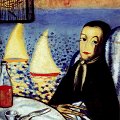 Salvador Dali is considered as the greatest artist of
the surrealist art movement and one of the greatest masters of art of
the twentieth century. During his lifetime the public got a picture of
an eccentric paranoid. His personality caused a lot of controversy.
After his death in 1989 his name remained in the headlines. But this
time it was not funny at all. The art market was shaken by reports of
great numbers of fraudulent Dali prints. What's all behind it?
Salvador Dali is considered as the greatest artist of
the surrealist art movement and one of the greatest masters of art of
the twentieth century. During his lifetime the public got a picture of
an eccentric paranoid. His personality caused a lot of controversy.
After his death in 1989 his name remained in the headlines. But this
time it was not funny at all. The art market was shaken by reports of
great numbers of fraudulent Dali prints. What's all behind it?
The Prodigy Child without an Exam
Salvador Dali was born as the son of a prestigious notary in the small town of Figuera in Northern Spain. His talent as an artist showed at an early age and Salvador Felipe Jacinto Dali received his first drawing lessons when he was ten years old. His art teachers were a then well known Spanish impressionist painter, Ramon Pichot and later an art professor at the Municipal Drawing School. In 1923 his father bought his son his first printing press.
Dali began to study art at the Royal Academy of Art in Madrid. He was expelled twice and never took the final examinations. His opinion was that he was more qualified than those who should have examined him.
Surreal Art
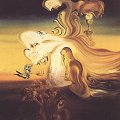 In 1928 Dali went to
Paris where he met the Spanish painters Picasso and Miro. He established himself as the
principal figure of a group of surrealist artists grouped around Andre
Breton, who was something like the theoretical "schoolmaster" of
surrealism. Years later Breton turned away from Dali accusing
him of support of fascism, excessive self-presentation and financial
greediness.
In 1928 Dali went to
Paris where he met the Spanish painters Picasso and Miro. He established himself as the
principal figure of a group of surrealist artists grouped around Andre
Breton, who was something like the theoretical "schoolmaster" of
surrealism. Years later Breton turned away from Dali accusing
him of support of fascism, excessive self-presentation and financial
greediness.
By 1929 Dali had found his personal style that should make him famous - the world of the unconscious that is recalled during our dreams. The surrealist theory is based on the theories of the psychologist Dr. Sigmund Freud. Recurring images of burning giraffes and melting watches became the artist's surrealist trademarks. His great craftsmanship allowed him to execute his paintings in a nearly photorealistic style. No wonder that the artist was a great admirer of the Italian Renaissance painter Raphael.
The Paranoid Critical Transformation Method
Of all the Surrealists and their achievements, there is one that stands out above all the others. The Paranoiac Critical method was a sensibility, or way of perceiving reality that was developed by Salvador Dali. It was defined by Dali himself as "irrational knowledge" based on a "delirium of interpretation". More simply put, it was a process by which the artist found new and unique ways to view the world around him. It is the ability of the artist or the viewer to perceive multiple images within the same configuration. As a matter of fact, all of us have practiced the Paranoid Critical Method when gazing at stucco on a wall, or clouds in the sky, and seeing different shapes and visages therein. Dali elevated this uniquely human characteristic into his own artform.
Dali, though not a true paranoid, was able to simulate a paranoid state, without the use of drugs, and upon his return to 'normal perspective' he would paint what he saw and envisioned therein.
Dali was able to create what he called "hand painted dream photographs" which were physical, painted representations of the hallucinations and images he would see while in his paranoid state. Although he certainly had his own load of mental problems to bear, it can be said that Dali's delusions and paranoid hallucinations did not totally dominate his mind, as he was able to convey them to canvas. Being a painter of miraculous skill, he was capable of reproducing his myriad fantasies and hallucinations as visual illusions on canvas.
Dali and Gala
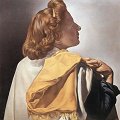 Meeting Gala was the most important event in the
artist's life and decisive for his future career. She was a Russian
immigrant and ten years older than Dali. When he met her, she was
married to Paul Eluard.
Meeting Gala was the most important event in the
artist's life and decisive for his future career. She was a Russian
immigrant and ten years older than Dali. When he met her, she was
married to Paul Eluard.
Gala decided to stay with Dali. She became his companion, his muse, his sexual partner, his model in numerous art works and his business manager. For him she was everything. Most of all Gala was a stabilizing factor in his life. And she managed his success in the 1930s with exhibitions in Europe and the United States.
Gala was legally divorced from her husband in 1932. In 1934 Dali and Gala were married in a civil ceremony in Paris and in 1958 in church after Gala's former husband had died in 1952. However from around 1965 on, the couple was seen less frequently together. But Gala continued to manage Dali's business affairs.
In the U.S.A.
In 1933 Salvador Dali had his first one-man show in New York. One year later he visited the U.S. for the first time supported by a loan of US $500 from Pablo Picasso. To evade World War II, Dali chose the U.S.A. as his permanent residence in 1940. He had a series of spectacular exhibitions, among others a great retrospective at the Museum of Modern Art in New York.
Besides creating a number of great paintings, Dali caused the attention of the media by playing the role of a surrealist clown. He made a lot of money and was contemptuously nicknamed Avida Dollars (greedy for dollars) by Andre Breton.
Dali became the darling of the American High Society. Celebrities like Jack Warner or Helena Rubinstein gave him commissions for portraits. His art works became a popular trademark and besides painting he pursued other activities - jewelry and clothing designs for Coco Chanel or film making with Alfred Hitchcock.
The Classic Period After World War II
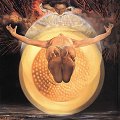 When Dali scholars speak
of Dali "becoming classic" what they mean is that he was following his
professed goal to embrace more traditional and universal themes in his
work. In early 1941, Gala managed to convince Dali that all of his
Surrealist glory was nothing, and that even greater heights were his
for the taking. It turned out that she was right, but it needs to be
mentioned that one of the main reasons for Dali's success was Gala
herself. She constantly advised him on how to act and interact with
the art community, especially while they were in America for most of
the 1940's.
When Dali scholars speak
of Dali "becoming classic" what they mean is that he was following his
professed goal to embrace more traditional and universal themes in his
work. In early 1941, Gala managed to convince Dali that all of his
Surrealist glory was nothing, and that even greater heights were his
for the taking. It turned out that she was right, but it needs to be
mentioned that one of the main reasons for Dali's success was Gala
herself. She constantly advised him on how to act and interact with
the art community, especially while they were in America for most of
the 1940's.
In 1948 Dali and Gala returned to Europe, spending most of their time either in their residence in Lligat/Spain or in Paris/France or in New York. Dali developed a lively interest in science, religion and history. He integrated things into his art that he had picked up from popular science magazines. Another source of inspiration were the great classical masters of painting like Raphael, Velasquez or the French painter Ingres. The artist commented his shift in style with the words: "To be a surrealist forever is like spending your life painting nothing but eyes and noses."
In 1958 the artist began his series of large sized history paintings. He painted one monumental painting every year during the summer months in Lligat. The most famous one, The Discovery of America by Christopher Columbus, can be seen at the Dali Museum in St.Petersburg in Florida. It is breath-taking. The artist's late art works combine more than ever his perfect and meticulous painting technique with his fantastic and limitless imaginations.
Death in His Own Museum
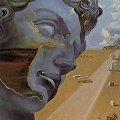 Salvador
Dali is the only known artist who had two museums dedicated
exclusively to his works at lifetime: the Dali Museum in St.
Petersburg in Florida/U.S.A., and Dali Museum-Theater in Figueres,
Spain.
Salvador
Dali is the only known artist who had two museums dedicated
exclusively to his works at lifetime: the Dali Museum in St.
Petersburg in Florida/U.S.A., and Dali Museum-Theater in Figueres,
Spain.
In 1980 Dali was forced to retire due to palsy, a motor disorder, that caused a permanent trembling and weakness of his hands. He was not able to hold a brush any more. The fact that he could not follow his vocation and passion of painting and the news of Gala's death in 1982 left him with deep depressions.
After Gala's death he moved to Pubol, a castle, he had bought and decorated for Gala. In 1984, when he was lying in bed, a fire broke out and he suffered sever burns. Two years later, a pacemaker had to be implanted.
Towards the end of his life, Dali lived in the tower of his own museum where he died on January 23, 1989 from heart failure.
Dali worked hard to establish an image of an eccentric and paranoid genius. Probably he only followed the rules of marketing a product - his own art. And the name of the game is "It is not important what you do as long as you are in the headlines."
The internationally renowned Dali expert and biographer, Robert Descharnes, wrote in 1995: "Those who are enthralled by artistic creation: those who possess the poet's capacity for wonder and dread; those who are inhabited by dreams; those who know that love and war were fundamental to human existence - such people will forget the few miasmas that are already being dissipated by the winds of time. They will encounter the landmarks that enable one to discover and comprehend the battle which Salvador Dali waged, all obstacles notwithstanding, in order to sow the seeds of the graphic art of tomorrow."
Quotes by Dali
- P. Halsman: Dali, what is surrealism? Dali: Surrealism is myself.
- At the age of six I wanted to be a cook. At seven I wanted to be Napoleon. And my ambition has been growing steadily ever since.
- Don't bother about being modern. Unfortunately it is the one thing that, whatever you do, you cannot avoid.
- Drawing is the honesty of the art. There is no possibility of cheating. It is either good or bad.
- Have no fear of perfection - you'll never reach it.
- I believe that the moment is near when, by a procedure of active paranoiac thought, it will be possible to systematize confusion and contribute to the total discrediting of the world of reality.
- I don't take drugs: I am drugs.
- It is either easy or impossible.
- Paranoiac-critical activity makes the world of delirium pass onto the plane of reality...
- The reason that some portraits don't look true to life is that some people make no effort to resemble their pictures.
- The secret of my influence has always been that it remained secret.
- The world will admire me. Perhaps I'll be despised and misunderstood, but I'll be a great genius, I'm certain of it.
Salvador Dali Art
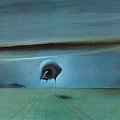
|
|
More
Articles
 Art Encyclopedia A world history of art in articles.
Art Encyclopedia A world history of art in articles.
Modernism
Salvador Dali
Art, life, and world of surreal.
Early years. Art, paintings, and works.
Surreal years. Art, paintings, and works.
Classical years. Art, paintings, and works.
Art
 Art Wallpapers Art image collections for your desktop.
Art Wallpapers Art image collections for your desktop.
Munch Art, $19
(75 pictures)
Malevich Art, $25
(105 pictures)
Modigliani Art, $29
(135 pictures)
Klee Art, $25
(150 pictures)
Miro Art, $35
(150 pictures)
Matisse Art, $29
(180 pictures)
Picasso Art, $29
(175 pictures)
Dali Art, $35
(275 pictures)
Chagall Art, $35
(175 pictures)

